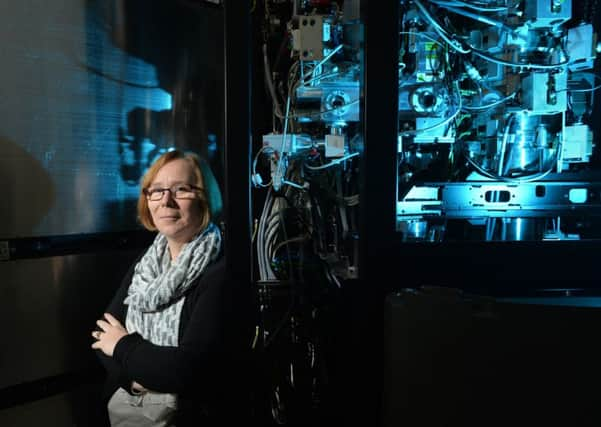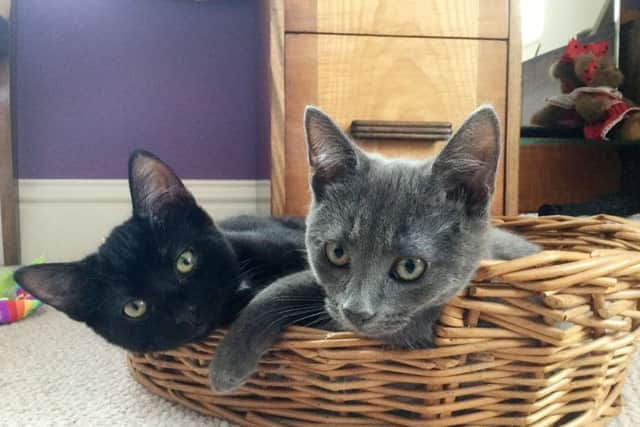'˜I'll never stop dancing' says Leeds biophysicist Professor Sheena Radford, who hopes to dispel stereotypes


Sheena Radford’s office at the University of Leeds is scattered with cat-themed ornaments, pictures and cards. There’s a sub-theme of origami here and there, too.
And then there are a couple of plastic models of strange 3D shapes - possibly made up of small components from a specialist Lego for science geeks. Then there’s a framed photo of her at St John’s College, Cambridge - a lone woman in a sea of around 70 men.
Advertisement
Hide AdAdvertisement
Hide AdShe’s just stepped off a plane from Belgium, after a work visit to the University of Leuven. Later there are Skype meetings and a tutorial. In between she’s teaching this arts graduate a few facts about proteins. None of us would exist without protein - “we are a bag of proteins”, she says - and the conundrums they present are Professor Sheena Radford’s life work.


I’m understating it a little when I say it’s pretty special to be in the same room with her, never mind having one of the foremost in her field worldwide explaining to me how proteins operate, using an origami swan to illustrate. The ready availability of said swan reassures me that this graphic demonstration of a fact of molecular biology is probably used on her students too.
“Proteins make your skin, muscle, the enzymes that digest…virtually all the reactions you need in a cell for movement, energy, respiration… everything is enabled by proteins. For a protein to perform its function it needs to fold (cue swan) into a particular shape in a certain order and direction”
There are a gazillion ways of doing it wrong, but only one way of getting the right structure… “One of the biggest questions in biochemistry lies in understanding protein folding so we can also understand what happens when it goes wrong, which it does more as we age, causing protein misfolding diseases such as Alzheimer’s and Parkinsons - but a host of other conditions, too. Understanding the rules of folding may mean we can correct misfolding and have therapies for ageing diseases. That’s what part of my lab is all about.”


Advertisement
Hide AdAdvertisement
Hide AdThe Prof has strings of letters after her name, earned at Birmingham, Cambridge and Oxford universities, and was lured to Leeds in 1995. A child who always wanted to know why things were the way they were, there was never any question that her career would be in maths or science. But what took her from undergrad to PhD to full-blown stellar academic career was the fact that she was having fun.
Born and bred in Manchester, and schooled at a solid comprehensive despite the qualms of her grammar school teacher parents, today she is the Astbury Professor of Biophysics at Leeds. In 2014 she was honoured with Fellowship of the The Royal Society, one of a venerable and elite group who have signed its register since it was instituted in 1660 - Newton, Darwin, Einstein and Rutherford among them.
She has a team of 70 scientists working in her lab, and manages a grant portfolio of £30m a year. Some of the team are helping to crack the protein folding/misfolding nut, and others work in adjacent fields of structural molecular biology. Some are researching the protein making factory inside bacteria, which enables them to build walls that are resistant to current drugs. Understanding this process could lead to a new generation of antibiotics that work in new ways.
The question of three objects to represent important areas of Sheena Radford’s life was quickly answered with an enormous electron microscope, a pair of dancing shoes and her beloved cats.
Advertisement
Hide AdAdvertisement
Hide AdWe move rooms to meet twin Titan Krios electron microscopes. They cost the University £17m in 2016 - helped by the Wellcome Trust and supported by Leeds City Council. They operate 24/7, 365 days a year, except for maintenance time - and their presence at the University has massively enhanced the research of hundreds of scientists. They are also used by industry, and students even at undergraduate level are allowed supervised access.
Millions of samples are being analysed every hour, making this equipment a real game-changer. “These are a generation of microscopes which mean we can see individual atoms in proteins - the biggest resolution you would ever need in biology. We can see individual molecules and see into cells.”
Two years have not dimmed Sheena Radford’s excitement, and she has been intimately involved with this project which has been transformative for the University. “We can now see molecules dancing and actually doing their reactions…Having this equipment has created a step-change in capability here at Leeds and revolutionised the University in the international arena of academia. Having industry also using the equipment enhances the translation of fundamental knowledge into potential therapies.”
Prof Radford sees her primary responsibility as being towards the Astbury Centre and University - “I am passionate about enabling everyone to succeed in the science they’re doing.” The second is towards herself and her research team, many of whom are young scientists still building their career. She wears many hats, her work attracts investment to the lab, and she and her team carry out groundbreaking research. Knock-backs are shared, then she leads the recovery. She says science is tough and requires resilience, but “It’s important to be human and caring in a tough world”.
Advertisement
Hide AdAdvertisement
Hide Ad“We are walking in the dark, blindfolded all the time… So much of science is about serendipity and open-mindedness and courage, saying ‘That looks interesting, let’s have a look.. ‘. But you have to be in the right place at the right time to actually pick up that chance observation. Then you have to be clever enough to make the most of those opportunities.”
The Prof says science can be “all-consuming” but a good work/life balance is essential - which brings us on to her two other ‘objects’.
“I’ve always been a cat lover and campaigned for one when I was six.” A determined character, she got her way. She and her husband Alan - also a scientist at Leeds - dance attendance on rescue moggies Basil and Sage, both boys. “They’re the light of my life and they love you, no matter what,” says the Prof. “However horrible I am, no matter what’s gone on at work, they tear around the house and make me laugh. It’s really important to me to sit and play with them in the evening, dangling their little toy turkey on a string.”
Spare time is spent in the garden, visiting the family cottage in Northumbria, baking and dancing. Her shiny black dancing sandals have many miles on the clock but are still hot to trot. “I started dancing while I was living in Oxford. I realised my life was pretty boring and full of academics, and I wanted to do something on Saturday nights that got me out of town. I saw an ad for a ballroom dancing class and I immediately adored it.”
Advertisement
Hide AdAdvertisement
Hide AdBefore long she was dancing four nights a week and even winning competitions. When Alan came along later, it was a case of joining in or not seeing much of Sheena. However busy they are, Saturday night dancing is a must. And yes, they are big Strictly fans.
“If you’re doing any dancing, especially something fast like a jive or quick step, you can’t be worrying about what’s going on at the University. I feel happy and light when I dance. I’ll never stop.”
Prof Radford is bouncy, funny, warm and obviously loves her job. I had no preconceived ideas of what a distinguished female scientist might be like, but she says a “crusty, tough stereotype” persists which she is keen to dispel. Has she succeeded?
